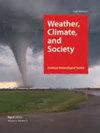Revisiting U.S. Nocturnal Tornado Vulnerability and its Influence on Tornado Impacts
IF 1.9
4区 地球科学
Q3 ENVIRONMENTAL STUDIES
引用次数: 3
Abstract
This research examines tornadoes and their fatalities by light condition (i.e., daytime and nighttime) for the United States. The study has two primary objectives: 1) catalog and reassess differences in daytime and nighttime, or nocturnal, tornadoes and their fatalities from spatial and temporal perspectives; 2) employ a spatially explicit Monte Carlo simulation technique to calculate differences in daytime and nocturnal tornado-population impact potential by combining climatological tornado risk data with fine-scale, gridded estimates of day and night population density. Results reveal that nocturnal tornadoes remain a substantial impediment to mitigating tornado casualties despite long-term improvements in detection and warning of these events. Nocturnal tornadoes are nearly twice as deadly as daytime events, with fatalities stemming from overnight (i.e., local midnight to sunrise) tornadoes increasing fourfold since the late 19th century. The proportion of all tornado fatalities that occurred during daytime hours has decreased 20% over the last 140 years, while the nocturnal fatality proportion has increased 20%. The stall, or even slight growth, in U.S. tornado mortality rates over the last 30 years has, at least in part, been driven by increasing nocturnal tornado fatalities. Overall, nocturnal tornadoes affect 13% more people on average compared to daytime tornadoes, revealing the importance of time of day in mitigating tornado-population impacts and disasters. Emergency managers, forecasters, first responders, policy makers, and researchers should continue to focus efforts on understanding nocturnal tornadoes, especially regarding how populations receive warnings and respond to these nocturnal threats.重新审视美国夜间龙卷风的脆弱性及其对龙卷风影响
本研究根据光照条件(即白天和夜间)对美国的龙卷风及其死亡人数进行了调查。该研究有两个主要目标:1)从空间和时间的角度对白天和夜间或夜间龙卷风及其死亡人数的差异进行分类和重新评估;2)利用空间显式蒙特卡罗模拟技术,将气候龙卷风风险数据与精细尺度、网格化的白天和夜间人口密度估算相结合,计算白天和夜间龙卷风人口影响潜力的差异。结果表明,夜间龙卷风仍然是减少龙卷风伤亡的一个重大障碍,尽管这些事件的探测和预警得到了长期的改进。夜间龙卷风的致死率几乎是白天龙卷风的两倍,夜间(即从当地午夜到日出)龙卷风造成的死亡人数自19世纪后期以来增加了四倍。在过去140年里,白天发生的所有龙卷风死亡人数比例下降了20%,而夜间死亡人数比例上升了20%。在过去的30年里,美国龙卷风死亡率的停滞,甚至是轻微的增长,至少在一定程度上是由于夜间龙卷风死亡人数的增加。总的来说,夜间龙卷风比白天龙卷风平均多影响13%的人,这揭示了一天中时间对减轻龙卷风对人口的影响和灾难的重要性。应急管理人员、预报员、第一响应者、政策制定者和研究人员应该继续努力了解夜间龙卷风,特别是关于人们如何接收警告并对这些夜间威胁作出反应。
本文章由计算机程序翻译,如有差异,请以英文原文为准。
求助全文
约1分钟内获得全文
求助全文
来源期刊

Weather Climate and Society
METEOROLOGY & ATMOSPHERIC SCIENCES-
CiteScore
3.40
自引率
13.60%
发文量
95
审稿时长
>12 weeks
期刊介绍:
Weather, Climate, and Society (WCAS) publishes research that encompasses economics, policy analysis, political science, history, and institutional, social, and behavioral scholarship relating to weather and climate, including climate change. Contributions must include original social science research, evidence-based analysis, and relevance to the interactions of weather and climate with society.
 求助内容:
求助内容: 应助结果提醒方式:
应助结果提醒方式:


